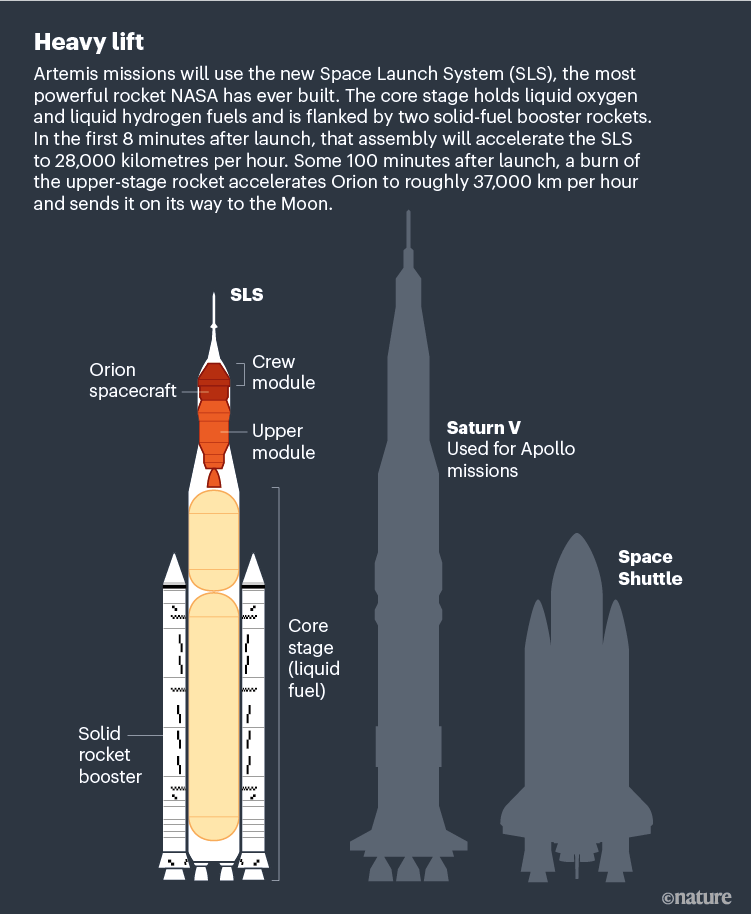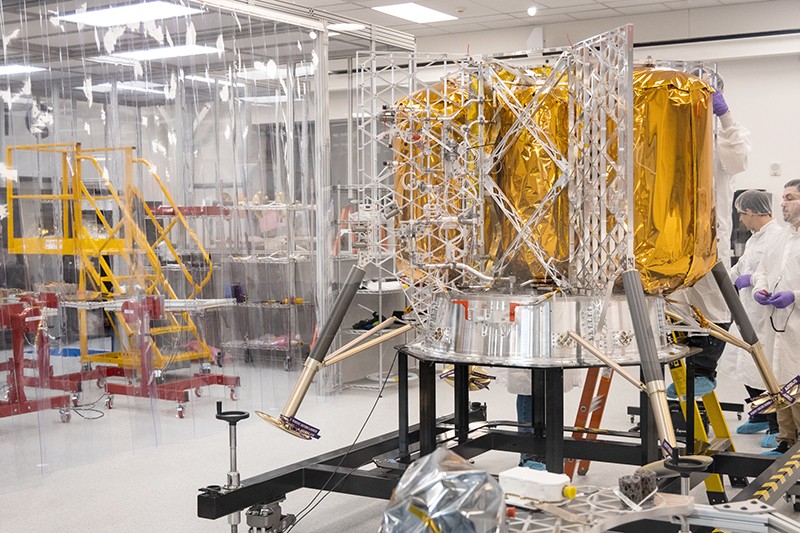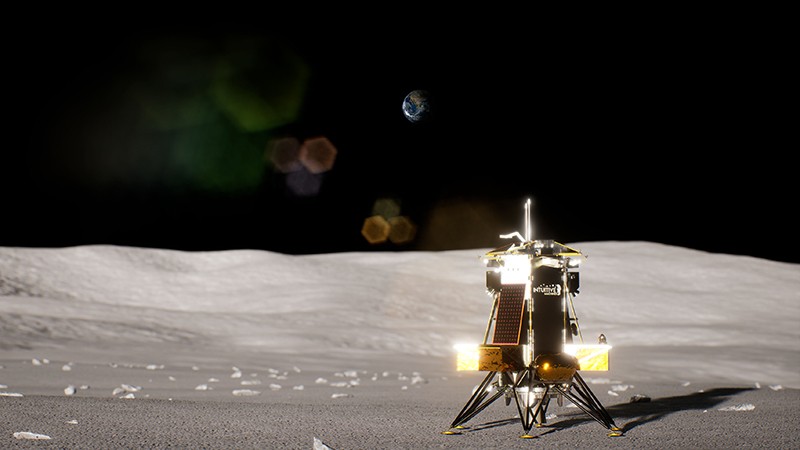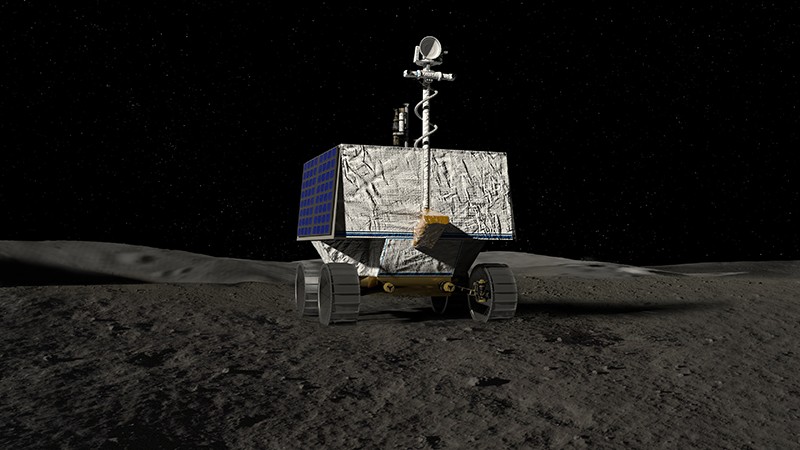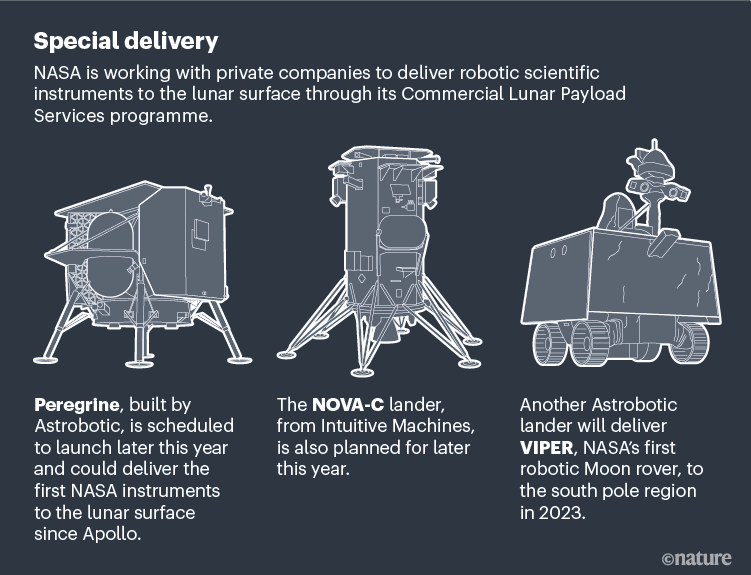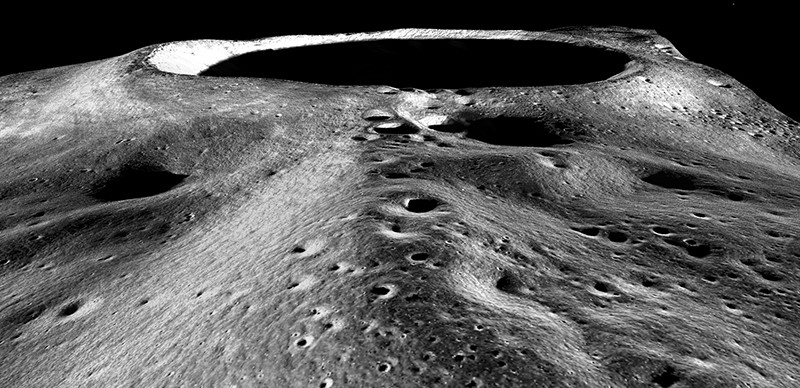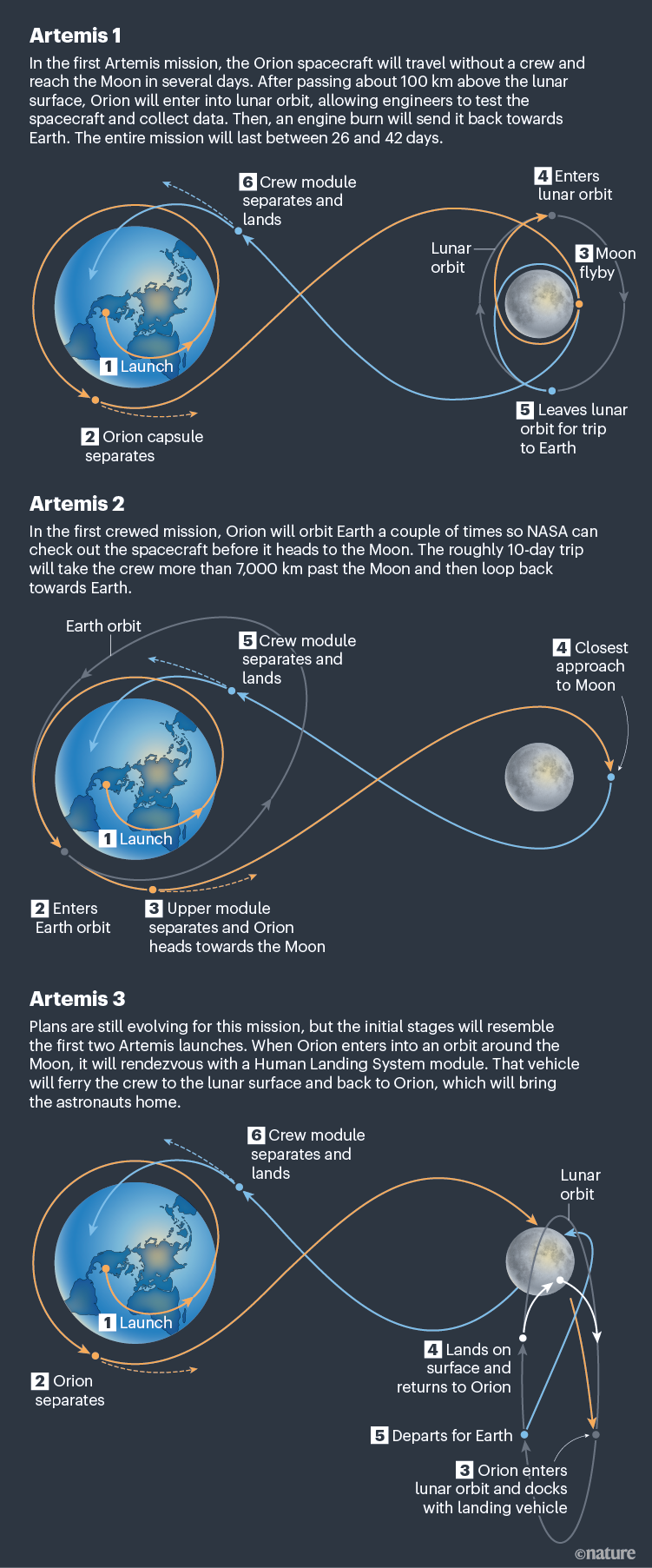Our #TECH_Newser covers ‘news of the day’ #techNewserTechnology content.
| cutline • press clip • news of the day |
The $93-billion plan to put astronauts back on the Moon.
On the morning of 17 March, the world’s largest set of doors rolled open to reveal an aerospace marvel at the Kennedy Space Center in Merritt Island, Florida. There, in NASA’s biggest building, stood its newest rocket — the most powerful ever built and nearly 100 metres tall. That evening, an enormous wheeled platform rolled slowly out of the building, carrying the mega-rocket through the coastal night towards its launch pad.
Like many space enthusiasts around the world, Renee Weber, a planetary scientist at NASA’s Marshall Space Flight Center in Huntsville, Alabama, stared in awe at the webcast feed. “That thing is going to the Moon,” she thought.
And unlike any rocket in the past half-century, that thing is going to carry people to the Moon. NASA plans to use it to send crews back to the lunar surface, more than 50?years after US astronauts last walked there during the Apollo programme. The upcoming push is called Artemis, after Apollo’s twin sister in Greek mythology.
NASA aims to kick off the Artemis era later this year, with the first launch of its mega-rocket, called the Space Launch System (SLS). That mission, dubbed Artemis 1, will fly without any crew around the Moon and back on a trip lasting between 26 and 42 days. NASA hopes to achieve its next giant goal, of landing astronauts at the lunar south pole, by the end of 2025. To support the Artemis programme, NASA has contracted companies to send a series of robotic landers to the Moon, which will carry NASA-funded instruments to explore its surface and enhance the science that could come from astronaut missions.
The Artemis programme faces huge challenges, notably whether the US Congress will be willing to pay the cost of several billion dollars per flight. But if it proceeds anything like NASA has envisioned, it will give a major boost to science education and public awareness, much as the Apollo programme, born from the cold-war-era space race between the United States and the Soviet Union, inspired a generation of scientists and engineers.
Science would benefit, too. The lunar south pole has never been explored by people or landers (although several robotic missions aim to get there before Artemis astronauts). Because sunlight never reaches parts of the south pole, some areas could have been frozen for billions of years. They might contain ice and other compounds that are rare on the mostly bone-dry Moon. By finding these volatile substances and studying them, scientists can gain insights into the origin and evolution of the Moon, as well as into the broader history of the Solar System, including Earth1.
“Think of it as building upon Apollo,” Weber says. “The Apollo programme completely revolutionized our understanding of lunar science and of the Moon itself.”
Gearing up to go
Artemis got its official start in 2017, when former president Donald Trump signed a space-policy directive telling NASA to focus on sending astronauts to the Moon. The roots of the idea trace back further, to at least 2004, when then-president George W. Bush prioritized sending astronauts to the Moon, and on to Mars. In response, NASA began designing heavy-lift rockets — precursors to the SLS — that could take people and cargo beyond low Earth orbit (see ‘Heavy lift’).
In 2010, president Barack Obama cancelled the Bush-era plans, telling NASA to focus on developing its rockets to send astronauts to an asteroid in preparation for going to Mars (thus sidestepping the Moon). Congress kept the rocket programme alive, providing tens of billions of dollars for NASA to develop the SLS. If and when it finally lifts off from the launch pad in Florida, the SLS will be NASA’s first new space-flight vehicle design since the Space Shuttle debuted in 1981. The SLS has been running into last-minute glitches, however. In April, an important test that was supposed to fill the rocket with fuel and then drain it revealed some problems, including a faulty valve and a hydrogen leak. NASA is working to fix the issues.
During the Apollo Moon landings from 1969 to 1972, 12 white men walked on the lunar surface. NASA has said that Artemis will land the first woman and the first person of colour on the Moon. Its astronaut corps includes several women of colour, including planetary geologist Jessica Watkins, who flew her first space mission — to the International Space Station — on 27 April.
Doug Hurley, a retired NASA astronaut who has flown in low Earth orbit, says that sending people back to the Moon will be an extraordinary moment in human history, especially with modern photos and videos of the Moon (see ‘Map of some Moon landings’). “The first human to see it with their own eyes in 50-plus years. It’s going to be huge,” he says. “It’ll be viral, those first pictures.”
Unlike the days of Apollo, Artemis is happening in an age when private aerospace companies are developing their own, smaller rockets to get to the Moon. This era of commercial space flight is opening up a wide range of opportunities for US scientists to send robotic missions to the lunar surface. “In the time since Apollo, we have not had regular surface access to the Moon,” says Barbara Cohen, a lunar scientist at NASA’s Goddard Space Flight Center in Greenbelt, Maryland.
NASA’s first return to the lunar surface could happen by the end of this year. If all goes to plan, two companies partly funded by NASA — Intuitive Machines in Houston, Texas, and Astrobotic in Pittsburgh, Pennsylvania — will make two landings on different parts of the Moon. Intuitive Machines is targeting a dark region called Oceanus Procellarum, carrying NASA instruments such as a video camera to capture the dust plume created by the lander as it touches down.
Astrobotic will travel to Lacus Mortis, a volcanic plain in the Moon’s northern hemisphere, with NASA instruments including a mass spectrometer that will measure how exhaust gases from the landing affect the chemistry of the lunar dirt. “By looking at how the gases interact with the surface, we can tell a lot about how they migrate and eventually get lost to space or trapped in cold polar reservoirs,” says Mehdi Benna, a planetary scientist at Goddard and principal investigator of the experiment.
These landers are the first in a series of NASA’s Commercial Lunar Payload Services, in which the agency hires companies to fly scientific instruments to the Moon rather than taking them there itself. It’s a risky proposition, because none of these companies has previously built lunar landers. At least five more landers are planned in the coming years, each going to a different location and carrying different scientific instruments.
Another Intuitive Machines probe is supposed to land in 2024 at Reiner Gamma, which is a striking example of a geographical phenomenon known as a ‘lunar swirl’. These are highly magnetized patches on the Moon’s surface that appear as sinuous bright patterns. The planned spacecraft, called Lunar Vertex, will place a small rover in Reiner Gamma to gather magnetic measurements to try to unravel how lunar swirls formed2.
The solar-powered rover will survive for just one lunar daylight period, or around 14 Earth days, but in that time it could roll hundreds of metres from its landing site — travelling across light- and dark-coloured parts of the swirls and measuring the strength and orientation of the magnetic fields in the rocks. “It’s definitely going to be the most intense two weeks of our lives,” says Sonia Tikoo, a planetary scientist at Stanford University in California, who works on Lunar Vertex.
In 2025, another commercial lander aims to bring two seismometers to the lunar far side; they would be the first seismometers on the Moon since the days of Apollo. By studying moonquakes generated by geological activity and by meteorites hitting the surface, scientists can refine their understanding of the Moon’s internal structure. Weber, who is part of the team, says this could be the start of a geophysical network on the Moon, much as the Apollo astronauts dropped off scientific packages including seismometers, magnetometers and other instruments at different locations. That observing array lasted until NASA switched it off in 1977. “To do the same experiment at different places is scientifically valuable,” Weber says.
Another future lander will target one of scientists’ most intriguing targets — lunar ice. Next year, NASA’s commercial programme will send a NASA-built rover named VIPER to the Moon’s south-pole region to search for ice. To be delivered by Astrobotic, the 2.5-metre-tall rover will scout for water and other volatiles frozen in the dirt, then use its 1-m-long drill to sample the ice. Instruments on board the rover will study the core fragments it pulls up. NASA wants VIPER to serve as a lunar prospector, gathering information on where volatiles are distributed, just as a gold miner would hunt for ore-rich veins. Any large quantities of water could serve as a resource for future lunar explorers.
Volatiles in the Moon’s polar regions are also a key science target for the first crewed Artemis landing. At the time of Apollo, scientists didn’t know that the Moon had any water. They thought the Moon lost all of its water during its formation in a giant impact, or in the deep chill of outer space over time. Preliminary evidence for a damp Moon emerged in the 1990s from US spacecraft such as Clementine3 and Lunar Prospector4. In 2009, India’s Chandrayaan-1 orbiter measured the frequencies of light that reflected off crater walls and other surfaces, which confirmed that the Moon contained small amounts of water, frozen in permanently shadowed regions at high latitudes5 (see ‘Where’s the water?’).
“That totally revolutionized our understanding of the lunar poles,” says Cohen. Since then, other scientists have expanded the study of lunar water to find it in other areas, even in sunlit portions of the Moon6.
Studying volatiles will reveal secrets not only about lunar history, but also about the rest of the inner Solar System, Cohen says. Mercury, for instance, retains ice in its shadowed polar craters even though it is the planet closest to the Sun and daytime temperatures can soar to 430?°C. How water got to the Moon, and how it survived, holds crucial insights for how this substance — which is crucial for life on Earth — became distributed throughout the Solar System. “We go now, armed with this new knowledge, and it will be fundamentally new science,” says Cohen.
The Apollo astronauts never went anywhere near the Moon’s poles. So Artemis astronauts would be the first people to explore this important region. The landing site for Artemis 3, which would be the first mission to carry astronauts to the surface, hasn’t been chosen yet but will be somewhere within six degrees of the south pole. Like the Apollo astronauts, the Artemis crew would walk or drive around their landing area, conducting experiments and picking up rock samples to bring back to Earth for analysis.
Where the Sun doesn’t shine
Several potential landing sites are near the 21-kilometre-wide Shackleton crater, which lies at the south pole and is named after the Antarctic explorer Ernest Shackleton. In a 6.5-day mission to Shackleton, astronauts could not only search for volatiles but also collect rocks left over from the magma ocean that once covered the Moon7. The impact that created Shackleton exposed chunks of this previously buried ancient lunar crust.
Living and working near the lunar south pole comes with unique challenges. Because the Moon isn’t tilted on its axis, as Earth is, sunlight does not always reach its poles. Some areas are permanently illuminated and others are in perpetual shadow. Each lunar day, the Sun circles low above the horizon, creating an otherworldly experience similar to the effect the midnight Sun has in the Arctic and Antarctic. Because the Sun is so low above the horizon and because the lunar landscape is so craggy, parts of the Moon, such as nooks in deep craters, can remain locked in shadow.
NASA is designing Artemis spacesuits that can withstand the huge temperature swings experienced from light to dark and back again. Cameras will need to have a high dynamic range, functioning equally well in deep shadow and bright sunlight. And even getting around on the surface will be challenging. “It will be a disorienting environment in which to operate,” says Jose Hurtado, a planetary geologist at the University of Texas in El Paso, who helps to train NASA astronauts. “You can imagine walking around at night with nothing but a flashlight.”
Artemis astronauts will train in field geology at night in rugged landscapes on Earth to prepare for the conditions that they might encounter on the Moon. Using artificial lighting, laser ranging, map displays or other technical aids could help them to get around more smoothly, says Carolyn van der Bogert, a planetary geologist at the University of Münster in Germany, who has analysed astronaut landing sites. “That’s going to be an improvement over what the Apollo astronauts had.”
Beyond the south pole landing, the Artemis programme envisions astronaut trips to other parts of the Moon, as well as building a lunar base and a Moon-orbiting small space station called the Gateway, for which the first components are supposed to launch in 2024.
The programme’s size and ambition pose huge challenges. There are financial questions about whether the agency will have enough money to pull off an astronaut landing in 2025; each Artemis launch is estimated to cost more than US$4?billion, or one-sixth of NASA’s entire budget. The whole programme, encompassing all the Artemis-related work across all of NASA’s divisions starting in fiscal year 2012, is estimated to cost $93?billion to the end of fiscal year 2025. There are also technical questions, such as whether the spacecraft that is to ferry astronauts from lunar orbit to the surface — which will be built by the US company SpaceX — will be ready in time.
NASA’s most optimistic planning documents show the Artemis 3 landing in 2025 and then a hiatus of astronaut landings until 2028.
Many lunar scientists say they will take whatever they can get. “I’m really excited for Artemis 3,” even if NASA doesn’t continue the programme after that, says Hurtado. “The ultimate hope is for a sustained presence on the Moon.”
Meanwhile, NASA continues to press forward with the plans to land people on the lunar surface. In the coming months, it will put out a call for teams of geologists who want to develop science plans for the Artemis-3 astronauts. US lunar scientists are scrambling to pair up with colleagues to compete for this first-since-Apollo opportunity.
For many, the return to the Moon is long past due and has the potential to reach far beyond the world of lunar science. “Apollo was just a stunning success,” says David Kring, a geologist at the Lunar and Planetary Institute in Houston. “I would like to see Artemis do the same thing for America and the world today. I think humanity would benefit from it.”
From an External Source.
First to share? If share image does not populate, please close the share box & re-open or reload page to load the image, Thanks!



